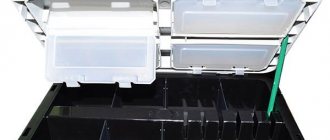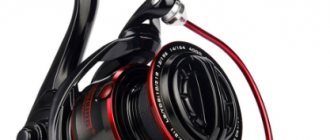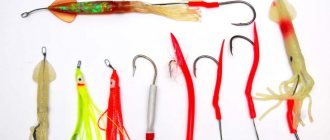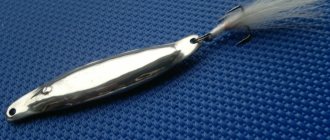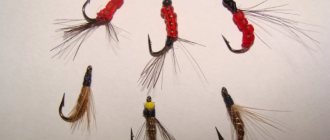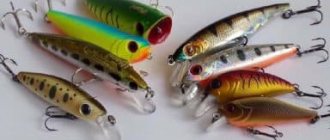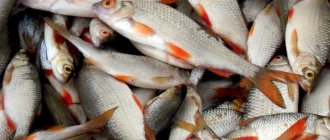Spider fishing is not clearly perceived by fishermen and, given some parameters of the device, is considered a purely poaching method of catching fish, which has nothing in common with sport fishing. But in some cases, fishing tackle is permitted for use under legitimate conditions and is an excellent help for anglers hunting for predatory fish and constantly in need of live bait. Such a tool can be purchased without any problems in a network of fishing stores and, equipped with a lightweight pole and a ten-meter piece of strong, small-diameter rope, can be used to ensure fishing with fresh live bait.
The article presented to the reader will help to understand the types of spiders for fishing, understand its operating principle and how to make it yourself. The fisherman will be given recommendations for choosing promising fishing spots with this tool, and the nuances of the geometric characteristics and devices permitted for its legal use will be discussed.
What is a spider fishing tackle?
A fishing spider, or also a product called a lift in the fishing community, is a fishing tool consisting of a square piece of mesh stretched between rigid metal rods of a frame, the upper part of which is connected to a specially designed device for this purpose, called a cross. Depending on the purpose of the spiders, they can have mesh fabrics of different sizes, which in turn can have different cell sizes. Spider fishing is done blind.
The gear is installed on the bottom at a point in the reservoir chosen by the fisherman and raised by means of a pole after a certain time interval, which is also arbitrary and depends only on the decision of the fisherman. The lift is convenient to use from bridges, or other building structures and objects of natural origin overhanging the water and convenient for the angler’s location. In this case, the net is lifted without a pole, using only a rope. When the device is lifted from the water, the fish swimming above the mesh sheet falls into a slug of gear formed from the water pressure and is taken to the shore. With this method of fishing, the caught fish has absolutely no damage, and can remain viable for a long time, kept in water under optimal temperature conditions.
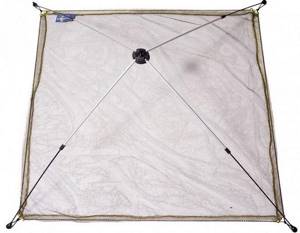
How to install a fishing lift
All citizens of our country can buy a fishing lift in Moscow. The equipment does not require skills; fishing is carried out blindly. The gear is installed at the intended fishing location, at the bottom of the reservoir. Using a pole or rope, the fisherman checks for the presence of fish in the trap. This is done at the request of the fisherman, after some time. The fish, which at this moment swims above the canvas, falls into a sack formed by water pressure and is taken to the shore. This fishing method is good because the prey does not receive damage and remains viable longer.
Types of spiders
The spider tackle, having a general principle of its operation, differs only in the size, shape and design of the cross. Otherwise, the composition of the tackle remains unchanged, consisting of a mesh fabric, a rod frame and a cross-lock. In appearance, a fishing lifting net can be a classic tetrahedral shape, a modernized hexagonal variation and separated into a separate direction and type of tackle - spider-shell. The shells are small in size and can be round in shape, in the form of four or six sides. Fishing for spiders can be carried out at different times of the year, and for these purposes, fishermen have developed structures that can sink under the ice. In continuation of the article, we will dwell in more detail on the most popular models of the device.
Important! But I would definitely like to note that the legal fishing tool is a spider with a web size of 100x100 cm and a cell size of 1x1 cm, called by fishermen a little spider.
Common for summer fishing
A fishing spider in a classic design is a little spider . It is with its help that fishermen catch the lion's share of live bait in the summer. The design of the tackle is quite simple and consists of a square mesh, a blind cross and four rods. On the crosspiece in its upper part there is a fastening ring for winding the lifting rope.
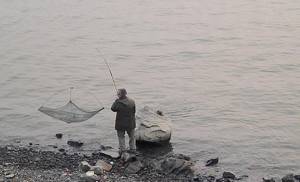
A wooden or aluminum pole for this small spider for catching live bait, as a rule, does not exceed four meters, and a seven-meter piece of rope or cord 6–8 mm thick is sufficient for most conditions for conducting the preparatory part of the main live bait fishing. Some models of the dwarf are equipped with side wing-aprons that rise 5–10 cm up along the perimeter of the mesh fabric. Their purpose is to serve to keep small fish in the mesh fabric, from rolling outside its boundaries at the moment when the tackle rises from the water.
For winter fishing
The design of the fishing gear for the peculiarities of winter fishing during the freeze-up period should allow the rods to fold freely when lowering and pulling the spider from the drilled hole. If the mesh fabric and rods of the winter version of the tackle are identical in appearance to the summer version, then the cross has a number of differences, which, first of all, lie in the spring mechanism that works to transform the product.
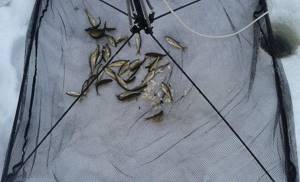
The stiffness of the spring is adjusted in such a way that it makes it possible to fold the rods and allow the angler to push the tackle through the hole, where, once in the water, it will open into working condition. When making a lift, resting the cross against the ice, the springs of the mechanism will work in the opposite direction and make it possible to lift into the hole a net folded into a bag with fish caught in it. To make it easier to feed the frame of this tackle, fishermen use ice drills of the largest diameters.
Features of a fishing lift
The spider lift for fishing can be of several types. The following types of products are distinguished:
- Malyavochnitsa – designed for catching live bait. Classic cross, small mesh (1x1 meter);
- Winter - the cross is equipped with a spring mechanism to improve the transformation of the structure. The rods are folded so that they can be inserted into the hole. Once in the water, the mechanism straightens out. When lifting, the rods rest against the ice, the structure folds in the opposite direction;
- Large – increased mesh size. The diameter of such a spider-lift is 1.5 meters or more. Used for industrial purposes;
Large spiders
Fishing with spiders in excess of the size standards specified in the previous sections of the article in the vast majority of regions of our country is poaching. But large lifts are used in industrial fishing by fishing teams and even vessels specialized for such a device. Of course, due to their large mass, such spiders cannot be lifted by hand and electric winches with metal cables are used for this. For fishing, the poacher uses an elongated and durable pole, but made of lightweight materials, and a reliable synthetic rope.
Important! It is tempting to catch unsuspecting migrating or roosting fish in large quantities in large quantities, but do not forget that for violations of the law there are now quite significant fines, for which it is better to acquire legal and high-quality fishing equipment for legal sport and amateur fishing.
How to make a fishing spider with your own hands
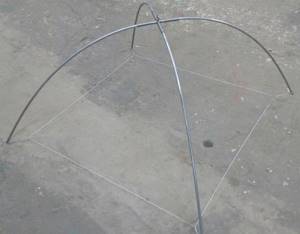
A fishing spider is a fairly elementary piece of equipment in its structure and composition of elements, and it can be made at home, with your own hands, without much difficulty. The basis of the equipment is the net; all other parts of the equipment can be adapted from available means, which makes it possible to assemble a spider even in the field. For the base of the lift, a network woven from synthetic threads, which are least susceptible to rotting, is suitable. You can use vine or willow twigs as arches, and equip the crosspiece with a strong joint knitting of four frame elements. Self-production of even such a primitive spider for fishing can allow you to catch a certain amount of fish in an extreme situation. But then we will discuss the possibility of manufacturing gear at home using the industrial method, giving not only the algorithm for assembling the gear itself, but also determining the list of materials and tools necessary for the production of the product.
Required materials and tools
Before starting the manufacture of the lift, you need to decide on the dimensions of the final product in order to correctly select the mesh fabric required in terms of area, and also purchase a sufficient amount of metal rod for the arcs of the device. As we have already mentioned, it is best to purchase a mesh made of nylon fishing line for lifts, which is a fairly durable synthetic material that does not require special care after using it in a damp environment. To stretch and attach the net to the arcs, you will need to purchase a polymer thread with a diameter of 2–3 mm, slightly larger than the length of the perimeter of the net. To make arcs, you need a rigid metal rod or reinforcement not exceeding 3 mm in diameter.
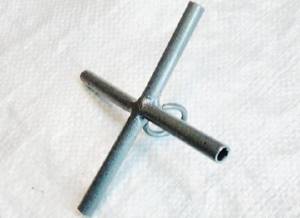
The fisherman will also need tubes for making a cross, the diameter of which should be comparable to the diameter of the metal rod that fits tightly into the hole of the pipe blank. Under the pole, wooden stakes or duralumin pipes up to six meters long and not exceeding 40 mm in thickness are used. To ensure the spider rises from the water, you will need about 10 meters of nylon cord no thicker than 8 mm.
Of the tools, the most complex equipment will be the welding machine, which will be needed to assemble the cross. In addition to welding equipment, you should have a small cutting machine or a hacksaw for metal, as well as pliers and a hammer for arranging hooks on metal rods for fastening the net. A sharp knife would be useful for working with nylon twine and tension threads.
Instructions for making a spider for fishing
Having decided on the size of the future lift, cut out the mesh fabric of the required perimeter and stretch a tension thread along its edges, which is tightly attached to the corners of the mesh, leaving loops. The next step is to prepare the crosspiece by welding its frame from tubes pre-cut to size. In the upper part of the cross, exactly in the center of the product, a fastening ring for winding the rope is mounted. Hooks are placed on four cut rods and loops made from thread drawn into the fabric are attached to them.
Next, the rods are tried on the crosspiece in such a way that when installing the rod into the hole of the tube on the canvas, a small sack is obtained, otherwise there is a sag of the mesh visible to the eye. The rods are cut to the required size and inserted into the crosspiece, completing the main assembly of the lift with your own hands with this operation. Now all that remains is to tie the fastening cord to the loop of the cross, connecting it to a pole selected for the fishing conditions, and you can go fishing.
What to make a spider cross from. How to make a spider for fishing and what types exist
Many homemade devices, invented and created by fishermen around the world not only in the 20th and 21st centuries, but also much earlier, are still used today in Russia. At the same time, some of the handmade products are, for unknown reasons, poachers, that is, prohibited by law.
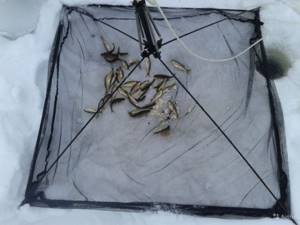
But they are still used in the country by thousands of underwater and ice fishing enthusiasts. At the same time, no one earned at least an extra thousand from fishing to buy a new net or modern fish bait. This can be said about fishing lift spiders.
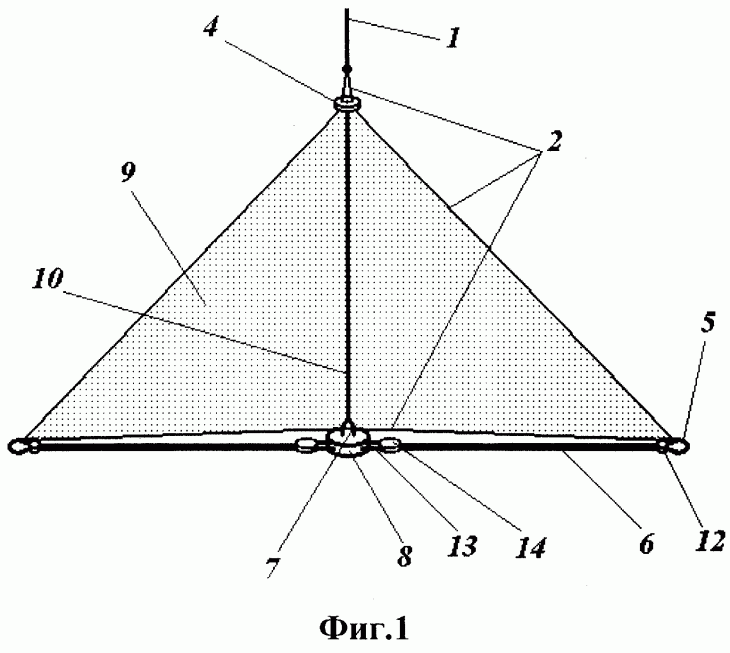
Brief contents of the review:
Four-legged device
Here are just a few such devices known to Russians: the “spider” fisherman, this article is dedicated to him today, as well as further - “kerchief”, “screen”, or “TV”, casting nets “American” or “Spanish” like “parachute” or "ring".
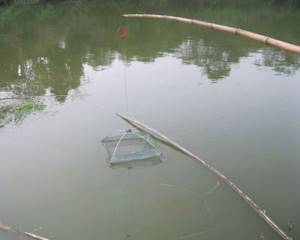
A few more words about the alleged spider poaching. But this tackle does not injure the fish in any way and does not cause damage to aquafauna.
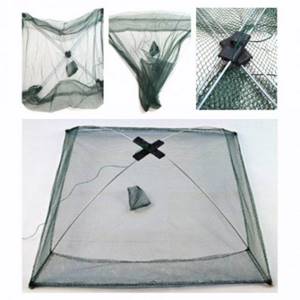
A spinning rod with one hook, and even more so with a whole link of hooks on one line, is more harmful to aquatic life than this device.
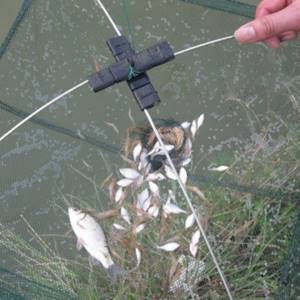
At the same time, double standards are often used in assessing the harmfulness of a particular device. For example, the same “parachute” allows legal entities to fish under license.
Public opinion in a number of regions, expressed in favor of one or another device, is sometimes beneficial. Since the same “spider”, or fishing lift, is already legalized in them for catching fry.

And a do-it-yourself spider-lift is no longer prohibited from being made or purchased in a specialized fishing net.
Best places to catch spiders
Spider fishing requires the angler to know places with clean bottoms that are free of snags, aquatic vegetation and construction debris that can get caught on the installed net. Reservoirs with a strong current, which can carry away a net with their flow, are not always convenient for fishing with a lift. Most suitable for fishing with this type of device are flat or slightly sloped bottoms next to underwater anomalies in the form of the same snags, massive stones, bushes of vegetation or reed walls.
Fishing is promising at the bottom of the pit, where the fish likes to hide during dangers, or after having fed during daylight hours, take refuge for the night. They always catch fish in water areas near bridges and directly under the structures themselves, where fish find secluded corners in parts of the reservoir shaded by the structure. Small fish, live bait, are caught on coastal shallows and sandy approaches to beaches, as well as in quiet creeks and backwaters, installing a lift near the boundaries of clear water and surface algae, mud collected in the quiet waters, or duckweed covering the reservoir.
Fishing tactics
To successfully fish for any spider, you need to know the topography of the pond. Experienced fishermen choose places:
- with a slight slope;
- next to a snag or log;
- near water thickets;
- under bridges or near the bottom of a pit.
After choosing a place for fishing, the spider is thrown into the water and periodically checked for catch. This method of fishing is suitable for daytime and nighttime. To simplify the procedure for pulling out a massive structure, another rope is attached to the pole.
We suggest you read: What kind of water should I put in the aquarium?
Features of fishing with a spider
Having decided on a suitable place on the pond, spider fishing begins with installing the gear. They try to silently lower the fishing device to the surface of the water at a promising point and let it sink deeper, settling on the bottom. The pole rope, attached to the handle, remains in the hands of the fisherman. After installing the spider, they wait for a certain period of time, which is initially set arbitrarily, finding out the density of fish in the fished area of the reservoir. After waiting time, they smoothly lift the net and, if there are fish, pull the device ashore, collecting the catch.
Important! If there are no results after a couple of lifts of the fishing gear, you need to increase the time you wait for the trophies to arrive.
Also, success can be brought by feeding the net installation area, when after casting, a portion of bait is fed into the lift, thus attracting live bait to the fishing site. Another effective method of fishing is to install a metal plate in the net that is different in color from the bottom, which attracts fish and also serves as a weight that allows you to install the net faster and improves its stability when fishing in currents.
